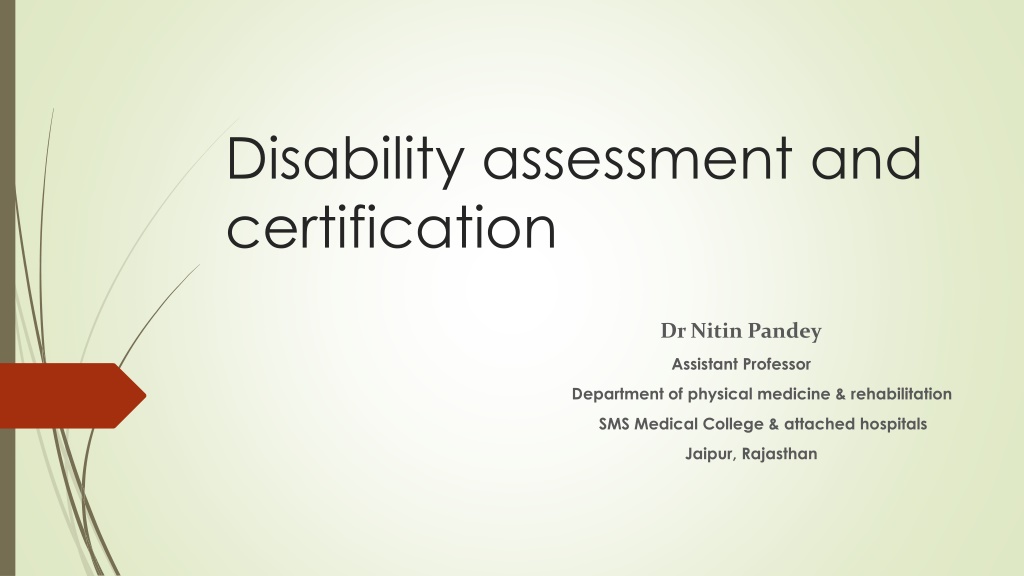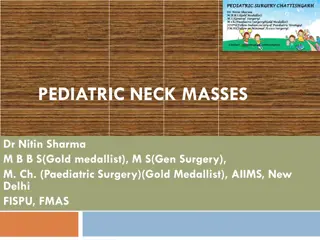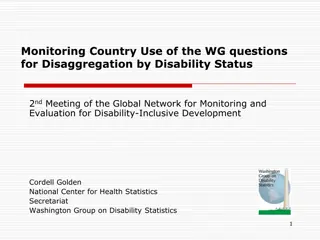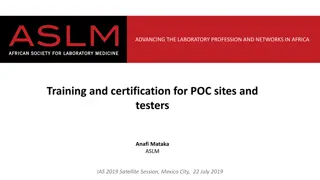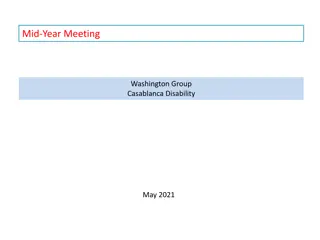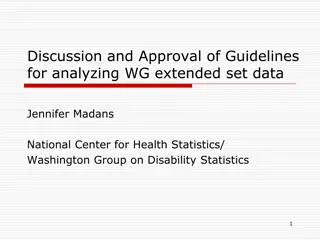Disability Assessment and Certification Guidelines by Dr. Nitin Pandey
Disability assessment involves evaluating impairments and functional limitations to determine disabilities, especially in the context of locomotor disabilities. Dr. Nitin Pandey outlines the criteria for certification, highlighting factors like muscle strength, joint motion, coordination, stability, and limb length. Certification is recommended for disabilities at or above 40%, post-treatment completion, and non-progressive conditions. The assessment includes detailed evaluations of upper limb components like arm and hand functionalities, with specific criteria and values assigned for each aspect.
- Disability assessment
- Certification guidelines
- Dr. Nitin Pandey
- Locomotor disability
- Musculoskeletal evaluation
Download Presentation

Please find below an Image/Link to download the presentation.
The content on the website is provided AS IS for your information and personal use only. It may not be sold, licensed, or shared on other websites without obtaining consent from the author. Download presentation by click this link. If you encounter any issues during the download, it is possible that the publisher has removed the file from their server.
E N D
Presentation Transcript
Disability assessment and certification Dr Nitin Pandey Assistant Professor Department of physical medicine & rehabilitation SMS Medical College & attached hospitals Jaipur, Rajasthan
Disability Impairment - Impairment is any loss or abnormality of psychological, physiological or anatomical structure or function Functional Limitations - Impairment may cause functional limitations Disability - : A disability is any restriction or lack of ability to perform an activity in the manner or within the range considered normal for a human being Loco motor Disability - Person s inability to execute distinctive activities associated with moving both himself and objects, from place to place and such inability resulting from affection of musculo-skeletal and/or nervous system
Variables-in assessing loco motor disability (PPI) In Loco motor Disability 1. Strength of Muscle (MMC) 2. Range of Joint Motion 3. Coordination 4. Stability 5. Limb length discrepancy 6. Hand Functions (prehension, sensation &strength) 7. Sensation 8. Deformity 9. Complications like pain, infection etc. 10.Extremity dominant or non-dominant.
When certification should be done Disability 40% or Above Treatment is complete Disability will not change Condition not likely to Progress PPI should be certified only after MMI
Upper Limb Assessment Arm Component 90% Hand Component 90%
ARM COMPONENT Each of the three joints of the Arm is weighed equally - 30% Strength of Muscles Range of Motion Coordination Form A in Gazette Notification 10 activities to be tested Each has value of 9% Combining Values = a+ b x (90-a)/90 Where a =higher value, b = lower value
HAND COMPONENT Total value of Hand Component is 90% The functional impairment of Hand is expressed as loss of Prehension loss of Sensation loss of Strength
PREHENSION Total value of Prehension - 30% Opposition 8% Tested against -Index finger 2% Middle finger 2% Ring finger 2% Little finger 2% Lateral pinch 5% Cylindrical grasp 6% Large object of 4 size (diameter) 3% Small object of 1 size (diameter) 3% Spherical grasp 6% Large object of 4 inches size 3% Small object of 1 inch size 3% Hook grasp 5%
SENSATION Total value of Sensation in Hand 30% Complete loss of Sensation Thumb ray 9% Index finger 6% Middle finger 5% Ring finger 5% Little finger 5% Partial loss of Sensation: Assessment should be made according to percentage of loss of Sensation in thumb/finger Evaluation of Strength 30% Grip Strength 20% Pinch Strength 10%
Additional weightage Total additional weightage 10% Pain Infection Deformity Mal-alignment Contractures Cosmetic disfiguration Dominant extremity-4% Shortening of upper limb - First 1 inch no weightage, for each 1inch beyond that -2% The extra points should not exceed 10% of the total Arm Component and total PPI should not exceed 100% in any case Combining Values
Lower Limb The measurement of loss of function in lower extremity is divided into two components: Mobility Stability components
Mobility Total value of Mobility component 90% It includes Range of Movement (ROM) 90% Muscle Strength 90% Three joints 30% each for ROM & Strength
Stability Total value of the Stability component 90% It should be tested by clinical method as given in Form B (Assessment Performa for lower extremity) There are nine activities, which need to be tested, and each activity has a value of ten per cent (10%) The percentage value in relation to each activity depends upon the percentage of loss of stability in relation to each activity
Extra points Extra points have been given for pain, deformities, contractures, loss of sensation and shortening Maximum points to be added are 10% (excluding shortening) Deformity In functional position 3% In non-functional position 6% Pain Severe (grossly interfering with function) 9% Moderate (moderately interfering with function) 6% Mild (mildly interfering with function) 3%
Extra points Loss of Sensation Complete Loss 9% Partial Loss 6% Shortening First 1/2 Nil (For every additional shortening 4% Complications Superficial complications 3% Deep complications 6%
Spine - Traumatic Cervical Spine injuries 25% or more compression of one or two adjacent vertebral bodies with No involvement of posterior elements. No nerve root involvement. Moderate Neck Rigidity and persistent Soreness 20% Posterior element damage with radiological evidence of moderate partial dislocation/sub-luxation including Whiplash injury With fusion healed, No permanent motor or sensory change - 10% Persistent pain with radiologically demonstrable instability 25% Severe Dislocation Fair to good reduction with or without fusion with no residual motor or sensory involvement 10% Inadequate reduction with fusion and persistent radicular pain 15%
Cervical Inter vertebral Disc Lesions in relation to spine Treated case of disc lesion with persistent pain and no neurological deficit 10% Treated case with pain and instability 15%
Thoracic and Thoraco-Lumbar Spine Injuries Compression of less than 50% involving one vertebral body with no neurological manifestation 10% Compression of more than 50% involving single vertebra or more with involvement of posterior elements, healed, no neurological manifestations Persistent pain, fusion indicated 20% Same as above with fusion, pain only on heavy use of back 15% Radiologically demonstrable instability with fracture or fracture dislocation with persistent pain 30%
Lumbar and Lumbo-Sacral Spine Compression of 25% or less of one or two adjacent vertebral bodies, No definite pattern or neurological deficit 15% Compression of more than 25% with disruption of posterior elements, persistent pain and stiffness, healed with or without fusion, inability to lift more than 10 kgs 30% Radiologically demonstrable instability in low lumbar or Lumbo-sacral spine with pain 35%
Disc lesion Treated case with persistent pain 15% Treated case with pain and instability 20% Treated case disc of disease with pain,activities of lifting moderately modified 25% Treated case of disc disease with persistent pain and of heavy weight stiffness; aggravated by lifting of heavy weight, necessitating modifications of all activities requiring heavy weight lifting 30%
NON TRAUMATIC LESIONS Scoliosis The largest structural curve should be accounted for, while calculating thePPI and not the compensatory curve or both structural curves Cobb s method for measurement of angle of curve 0-20 Nil 21-50 10% 51-100 20% 101 & above 30% Torso Imbalance - Deviation of Plumb line Up to 1.5 cms 4% 1.5-3.0 cms 8% 3.1-6.0 cms 16% 6.1 cms and more 32%
Head Tilt over C7 Spine Upto 15 4% More than 15 10% Cardiopulmonary Test
Kyphosis Spinal Deformity Less than 20 Nil 21-40 10% 41-60 20% Above 60 30% Torso Imbalance Less than 5 cm in front of ankle 4% 5 to 10 cm in front of ankle 8% 10 to 15 cm in front of ankle 16% More than 15 cm in front of ankle 32%
Amputation Basic considerations In case of multiple amputees if the total sum of permanent physical impairment is above 100%, it should be taken as 100% only. If the stump is unfit for fitting the prosthesis, additional weight-age of 5% should be added to the value.
Amputation Basic considerations In case of amputation in more than one limb percentage of each limb is added by combining formula and another 10% will be added but when only toes or fingers are involved only 5% will be added. Any complication in form of stiffness of proximal joint, neuroma, infection etc.,should be given up to a total of 10% additional weight-age. Dominant upper extremity should be given 4% additional weight-age.
Thanks for being patient Thanks for being patient
